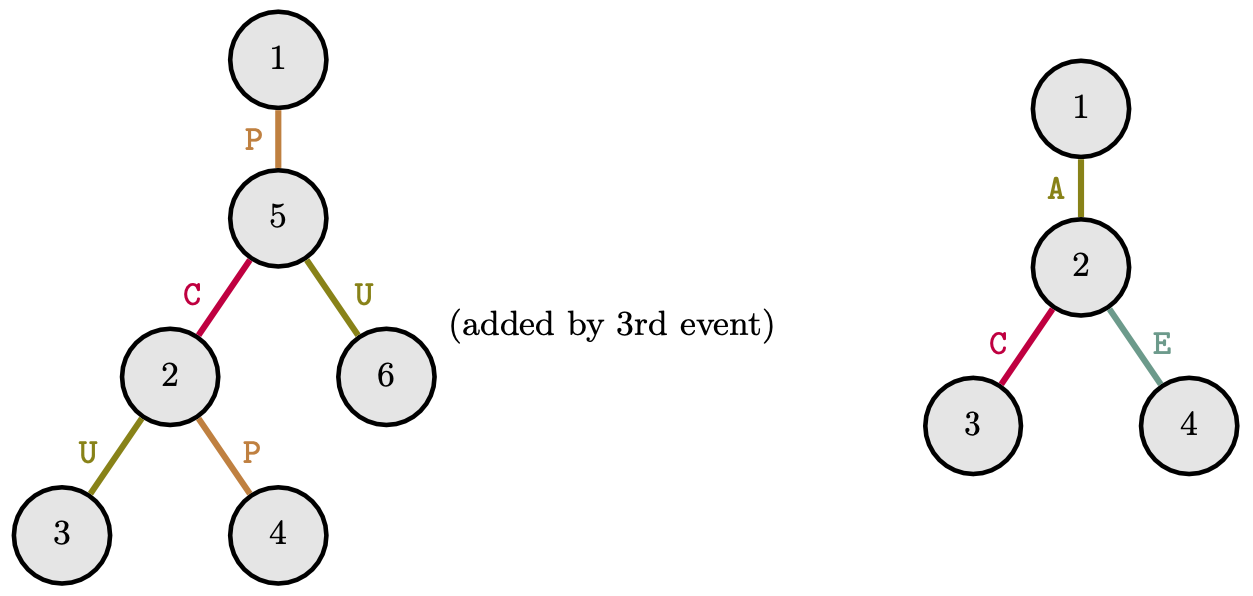Alphonse is assembling an alphabet tree and arranging some adventures along the way.
An alphabet tree is an unrooted tree with N N nodes (numbered from 1 to N) and N−1 edges.
Initially, the ith edge connects nodes Ai and Bi in both directions, and is labeled with a uppercase letter Ci. Two edges incident to a common node are always labeled with different letters.
Alphonse has Q events to process, the ith of which is one of two types:
- 1 Ui Li : Add a new node to the tree by connecting it to node Ui with a new edge labeled with uppercase letter Li. Newly added nodes are numbered with integers starting from N+1 in the order they're added.
- 2 Ui Ki Si : Print the final node Alphonse will end up at if he:
- Starts a journey at node Ui.
- Repeatedly traverses a previously untraversed edge (on this journey). If his current node has multiple untraversed edges, he picks the edge labeled with the letter that comes earliest in the string Si.Ends the journey once there are no more untraversed edges at the current node, or Ki edges have been traversed on the journey.
Please help Alphonse determine where each journey will take him.
Constraints
- 1≤T≤20
- 2≤N≤300,000
- 1≤Q≤300,000
- 1≤Ai,Bi≤N
- Ai≠Bi
- Ci,Li,Si,j∈{′A′,⋯,′Z′}
- 1≤Ui,Ki≤600,000
- The sum of N over all test cases is at most 1,100,000.
- The sum of Q over all test cases is at most 1,100,000.
For each event, it is guaranteed that:
- Ui is a valid node in the tree at the time of the event.
- Li is different from all existing labels of edges incident to Ui at the time of the event.
- Si's letters are distinct, and are a superset of all edge labels in the tree at the time of the event.
Input Format
Input begins with a single integer T, the number of test cases. For each test case, there is first a line containing a single integer N. Then, N−1 lines follow, the ith of which contains space-separated integers Ai and Bi, followed by a space, followed by Ci. Then, there is a line containing the single integer Q. Then, Q lines follow, the ith of which is either 1 Ui Li or 2 Ui Ki Si.
Output Format
For the ith test case, print a single line containing "Case #i: ", followed by space-separated integers, the answers to all type-2 events.
Sample Explanation

The first sample case's alphabet tree is depicted above, and yields the following journeys:
- Event 1 traverses 1M⟶2E⟶6 (ended after no more edges from node 6)
- Event 2 traverses 3E⟶1T⟶4A⟶9(ended after K2=3 steps)
- Event 3 traverses 9A⟶4T⟶1M⟶2 (ended after K3=3 steps)
- Event 4 traverses 8M⟶3E⟶1T⟶4A⟶9 (ended after no more edges from node 9)
- Event 6 traverses 8T⟶10 (ended after no more edges from node 10)
The second and third sample cases are depicted below.

In the second case, the journeys are:
- Event 1 traverses 1P⟶5C⟶2 (ended after K1=2 steps)
- Event 2 traverses 4P⟶2C⟶5P⟶1 (ended after K2=3 steps)
- Event 4 traverses 4P⟶2C⟶5U⟶6(endedafterK_4 = 3$ steps)
- Event 5 traverses 3U⟶2P⟶4 (ended after no more edges from node 4)
In the third case, the journeys are:
- Event 1 traverses 3C⟶2A⟶1 (ended after K1=2 steps)
- Event 2 traverses 4E⟶2A⟶1 (ended after K2=2 steps)
- Event 3 traverses 1A⟶2 (ended after K3=1 steps)
Sample Input
3 9 1 2 M 1 3 E 1 4 T 4 9 A 2 5 T 2 6 E 3 7 A 3 8 M 6 2 1 3 META 2 3 3 TEAM 2 9 3 MATE 2 8 8 TEAM 1 8 T 2 8 8 TEAM 5 1 5 P 5 2 C 2 3 U 4 2 P 5 2 1 2 CPU 2 4 3 CUP 1 5 U 2 4 3 CUP 2 3 4 PUCK 4 2 1 A 2 3 C 4 2 E 3 2 3 2 HACKER 2 4 2 REACH 2 1 1 OCEAN
Sample Output
Case #1: 6 9 2 9 10 Case #2: 2 1 6 4 Case #3: 1 1 2